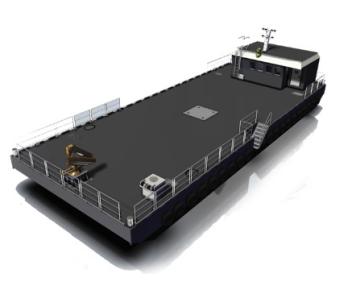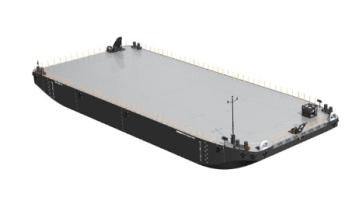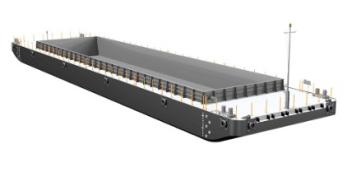Where road and rail transport are not possible due to lack of infrastructure it may be necessary to transport goods by river, delta, marshes, canals or other form of inland waterways. The mode of transport will be informed by the nature of the inland waterway, including depth, water current, necessity for speed of delivery, and ability to load/offload at remote locations and destinations.
Barges
Under very specific circumstances, barges can be an extremely cost-effective way of moving large volumes of cargo relatively large distances. Barges are wide, flat river vessels with low edges, have flat bottoms, and have a shallow draft. This makes barges ideal for use in calm flat and shallow waters like a river, but largely unsuitable for turbulent waters like the open ocean. Barges can come in two configurations:
Self-propelled – Self-propelled barges have a connected cabin and engine mount, and move as a single piece. Usually the engine is designed for moving large loads, but isn’t meant for speed.

Dumb Barge – A “dumb” barge is an non self-powered floating platform, capable of holding cargo, but is without steering or an engine. Dumb barges require an external boat to move, including a tow boat or a “pusher,” a separate motivated boat that is specifically designed to push or pull dumb barges along waterways.

The barges themselves are divided into three general categories:
Flat Deck – A barge on which the deck stowage is one large flat surface, upon which cargo rests and is secured to. Flat deck surfaces on barges are very exposed - they won't protect cargo from waves or from turbulent water, and items stored on the surface of flat decks can be easy targets for thieves. All cargo transported on the surface must be properly secured and tied down, and valuable items stored in a manner that won't enable easy theft.

Hopper / Split Hopper – A barge with one large or many smaller compartments that are partially below the edge of the barge. Hoppers can be used to store bulk loose items such as grains, sand or ore. Many hoppers can be covered with tarp or hard metal lids to protect contents, and some can even store additional cargo on top of the hopper compartments. Depending on the cargo, hopper/split barges can be loaded by hand or specialised MHE.

Tanker Barge - A barge designed to carry liquids or compressed gasses. Tanker barges requires specialised maintenance, and will only be used if the sending and receiving ports have the proper equipment to load and offload.

Barge movement is likely the cheapest mode of moving cargo inland into a country, however it has limitations. Barging operations are extremely slow; the loading and offloading process can take days or weeks depending on the load type and the journey itself can take weeks to accomplish. Barges are also further limited by the ability to safely moor and offload at the point of delivery. Barges themselves can be impacted by seasonal changes to the riverway, making areas impassable for periods of time.
In reality, there are only a few locations globally where barges will be effectively used in a humanitarian response operations. There is no standard form of documentation for utilising barges, and users of barge services will need to supply their own tracking documentation and process their own customs formalities if required to.
Boats
Inland water ways can be navigated by boats of the appropriate sizes. Smaller boats have the advantage of moving quickly and fitting into smaller water inlets, however will also be limited in the volume of cargo they can carry. Agencies may wish to rent or lease their own boats for rapid response operations.
There may also be large riverway shipping operations on vessels capable of carrying relatively large volumes of cargo. Utilising third-party riverway shipping should be treated the same as utilising any local third-party transport.

